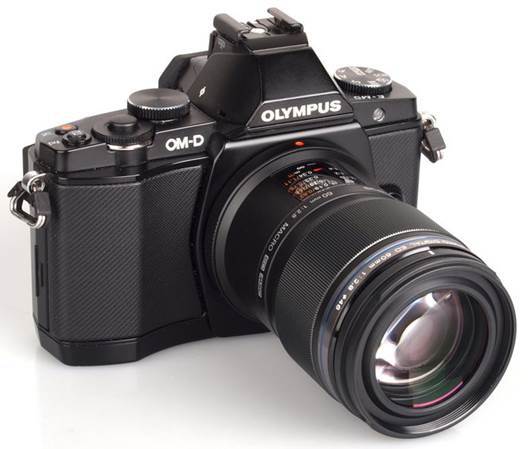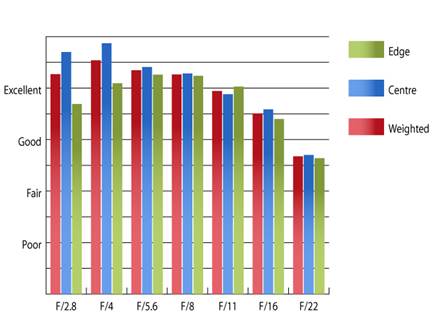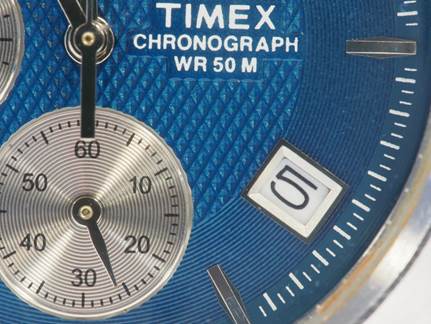This telephoto macro lens provides cameras
the Micro Four Thirds system from Olympus which offers a view angle equivalent
to 120mm lens using on a 35mm camera. There is also a MSC focus motor which is
very quiet and creates life size magnification at its closest focal length.
Handling and features
Weighting just 185g, this lens is really
compact and light when comparing with the other telephoto macro lenses
equivalent to 35mm or the APS-C camera system. Dustproof, moisture-proof and
light-weight, it sets a good balance when using with Panasonic Lumix DMC-G3
which is chosen for testing, and they work just like brothers, even on the most
compact Micro Four Thirds system.

The
telephoto macro lens
The auto focus is conducted internally, quickly
and very precisely and locks the subjects at normal distance immediately. If
hunting for focus is needed, which is very likely to happen in low-light
shooting conditions or close distance, a focus limiter switch is provided to
limit the amount of hunting. There are also settings to move the focus to its
closest points automatically in this switch. Sometimes, on the testing
Panasonic camera, using this feature may create a warning asking you to use
manual focus, but not in all cases. The manual focus ring operates smoothly and
is well damped, making focus adjustments relatively easier.

Life
size magnification at the closest focal length
The closest focal length is 19cm, letting
you get reasonably close for frame filling shots and also providing proper working
distance at the same time. On the front side of the lens you will clearly see a
useful distance scale with magnification values clearly.
There is a 46mm filter thread provided,
which does not rotate when focusing and no extension of the lens. This makes
the lens very ideal to be used with polarized filter and GND. There is,
unfortunately, no lens hood as standard. The optical LH-49 hood retails for $68
if you need. This hood features new sliding design, allowing it to be pulled
back to the barrel when it is unnecessary or when shooting at close distance.

The
closest focal length is 19cm
Performances
This compact telephoto lens leaves the
impressions of extraordinary sharpness in the center of the frame at maximum
aperture, and the clarity towards the edges is very good. Stopping down the
aperture leads to obvious enhancement of the center’s sharpness to f/4, and
improve clarity towards edges to f/5.6. The sharpness starts to be diffracted
at smaller aperture, but the clarity is still kept at excellent level across
the frame until f/8.

The
resolution at 60mm
How
to read our chart?
The blue columns represent the figures
recorded in the center of the frame at many different apertures, and the green
ones show that towards the edges. Their advantages make up the red columns.
The scale on the left indicates the real
resolutions of the image. The higher the column, the better performance the
images have, just as simple as that.
For this review, the lens is tested on the
Panasonic Lumix G3 using Imatest.
The chromatic aberration is
well-controlled, just exceeding half a pixel width towards the edges of the
frame for most apertures. If stopping down more than f/16, the fringing
surround the frame would be clearly visible, so it should be very careful to
take a shot of high-contrast subject at very small aperture.

Chromatic
aberration at 60mm
How
to read our chart?
Chromatic aberration indicates the
inability of the camera to focus on sensor of film all of the visible light
color simultaneously. Extreme chromatic aberration creates sharp fringing or
halo effect around the sharp edges of the frame. They can be eliminated by
software.
The Apochromatic lens owns special elements
(aspheric, low-polarized...) which can minimize the problems, so it usually
cost more.
For this review, the lens is tested on a
Panasonic Lumix G3 camera using Imatest.
Falloff of illumination towards the corners
of the frame is well controlled for this kind of lens. The frame is just 1.02
stops darker at f/2.8, compared the center, and the illumination is uniform
when the lens is stopped down to f/4 onwards.
Just 0.253% barrel distortion is detected
by the Imatest during the test, which is really an extremely low level. This
distortion level is too low that makes the lines running parallel with the
frame’s fringing literally straight.
Even when shooting into the light, this
lens is anti-glare and provides high contrast in most of the case, except for
shooting under the most extreme environments.
Sample
photos

Stopping
down creates excellent sharpness across the frame | 1/500 sec | f/6.3 | 60.0 mm
| ISO 160

Impressive
performance of the maximum aperture at the center of the frame| 1/1600 sec |
f/2.8 | 60.0 mm | ISO 160

Life
size magnification at the minimum focus length of 19cm | 3.2 sec | f/8.0 | 60.0
mm | ISO 200

The
contrast is still good when shooting into light | 1/800 sec | f/2.8 | 60.0 mm |
ISO 160

1/640
sec | f/6.3 | 60.0 mm | ISO 160

1/1300
sec | f/2.8 | 60.0 mm | ISO 160

1/125
sec | f/2.8 | 60.0 mm | ISO 160

1/640
sec | f/2.8 | 60.0 mm | ISO 160

1/125
sec | f/5.6 | 60.0 mm | ISO 320

Chân
dung | 1/160 sec | f/11.0 | 60.0 mm | ISO 200
Value
Admittedly, there is no direct equivalent
rival for this lens currently in the Micro Four Thirds segment. Its price of
$555, which is relative a temporary one, reveals that this lens will be capable
of providing features on offer.
The nearest equivalent rival for the Micro
Four Thirds camera system could be the Leica 45mm f/2.8 from telephoto from
Panasonic, retailing at $825.
Conclusion
This lens provides a wonderful combination
of the excellent optic performance, weight, compact design and worth the money.
The owners of the Micro Four Thirds who are
fancy of macro photography should definitely add this product into their dream
list. Actually, even though you are not very interested in macro shooting, this
lens might also impress you with its quality and affordable price, which makes
it the most rational choice for portraits shooting on a relative budget.
Advantages
·
Really good performance with proper price
·
Good built quality
·
Light
·
Compact
·
Dustproof and moisture-proof
Disadvantages
·
No hood provided as standard
·
Optional sliding hood is quite expensive
Verdicts
·
Feature: 4/5
·
Handling: 5/5
·
Value: 4.5/5
·
Overall: 4.5/5
Specifications
|
General
·
Lens Mounts: Panasonic Micro Four Thirds,
Olympus Micro Four Thirds
Lens
·
Focal Length: 60mm
·
Angle of View: 20°
·
Max Aperture: f/2.8
·
Min Aperture: f/22
·
Filter Size: 46mm
·
35mm equivalent: 120mm
·
Internal focusing: Yes
Focusing
·
Min Focus: 19cm
·
Stabilized: No
Construction
·
Blades: 7
·
Elements: 13
·
Groups: 10
Box Contents
·
Box Contents: M.ZUIKO DIGITAL ED 60mm 1:2.8
Macro, LC-46 Lens Cap, Micro Four Thirds lens rear cap (LR-2), Warranty Card,
Operating Instructions
Dimensions
·
Weight: 185g
·
Height: 82mm
|